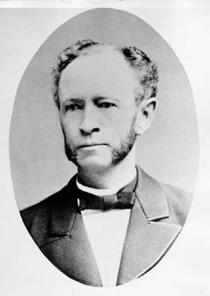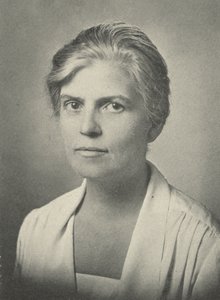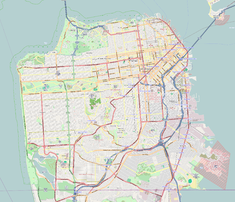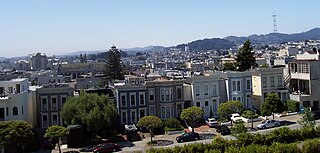
Thomas Starr King, often known as Starr King, was an American Universalist and Unitarian minister, influential in California politics during the American Civil War, and Freemason. Starr King spoke zealously in favor of the Union and was credited by Abraham Lincoln with preventing California from becoming a separate republic. He is sometimes referred to as "the orator who saved the nation".

Jane Elizabeth Lathrop Stanford was an American philanthropist and co-founder of Stanford University in 1885, along with her husband, Leland Stanford, in memory of their only child, Leland Stanford Jr., who died of typhoid fever at age 15 in 1884. After her husband's death in 1893, she funded and operated the university almost single-handedly until her unsolved murder by strychnine poisoning in 1905.

Washington Square is an American park in the North Beach district of San Francisco. It was established in 1847 and is one of the city's first parks. The park is bordered by sidewalk cafes and restaurants such as Mama's (restaurant), Park Tavern restaurant and the Liguria Bakery as well as the Sts. Peter and Paul Church.

The San Francisco Columbarium & Funeral Home is a columbarium owned and operated by Dignity Memorial, located at One Loraine Court, near Stanyan and Anza Streets, just north of Golden Gate Park in San Francisco, California. Built in 1898 by architect Bernard J.S. Cahill, the copper-domed Columbarium is an example of neoclassical architecture. It is the only non-denominational burial place within San Francisco's city limits that is open to the public and has space available.

Geary Boulevard is a major east–west 5.8-mile-long (9 km) thoroughfare in San Francisco, California, United States, beginning downtown at Market Street near Market Street's intersection with Kearny Street, and running westbound through downtown, the Civic Center area, the Western Addition, and running for most of its length through the predominantly residential Richmond District. Geary Boulevard terminates near Sutro Heights Park at 48th Avenue, close to the Cliff House above Ocean Beach at the Pacific Ocean. At 42nd Avenue, Geary intersects with Point Lobos Avenue, which takes through traffic to the Cliff House, Ocean Beach and the Great Highway. It is a major commercial artery through the Richmond District; it is lined with stores and restaurants, many of them catering to the various immigrant groups who live in the area. The boulevard borders Japantown between Fillmore and Laguna Streets.

The First Unitarian Church of Oakland is located in western Downtown Oakland, California. It is a member of the Unitarian Universalist Association.
Starr King School for the Ministry is a Unitarian Universalist seminary in Oakland, California. The seminary was formed in 1904 to educate leaders for the growing number of progressive religious communities in the western part of the US. The school emphasizes the practical skills of religious leadership. Today, it educates Unitarian Universalist ministers, religious educators, and spiritual activists, as well as progressive religious leaders from a variety of traditions, including Christianity, Islam, Judaism, Buddhism, earth-centered traditions, and others.

Visitacion Valley, colloquially referred to as Viz Valley, is a neighborhood located in the southeastern quadrant of San Francisco, California.

James Otis was an American politician. He was active in San Francisco, where he served as mayor from 1873 to 1875.

Cathedral Hill is a neighborhood and a hill, in the Western Addition district of San Francisco, California.

Rev. Bradford Leavitt was an American minister. He was a Harvard-educated Unitarian minister named pastor of San Francisco's First Unitarian Church in 1900 – six years before the San Francisco earthquake. Leavitt served the church during and after the disaster, earning a reputation for effective leadership. During his time at First Unitarian, Leavitt also wrote editorials for The San Francisco Chronicle. Later the activist Leavitt exposed corruption in San Francisco's government, resulting in the Mayor's conviction on corruption charges, as well as the resignation of the city's entire Board of Supervisors.

The First Unitarian Church of San Jose is located at 160 North Third Street in downtown San Jose, California, across from St. James Park, and was designed in "Richardsonian Romanesque" style by architect George Page, who also designed the Hayes Mansion. Local historian Linda Larson Boston called the building, “One of a handful of American churches patterned after Unitarian churches of Transylvania, it features a large triple-arched stained glass window on the facade, multiple domes and cupolas, and both round and square towers,” in her pamphlet, Highlights of San Jose, California’s St. James Park and Environs. The congregation purchased the site in 1888, and the cornerstone was laid in a ceremony on September 23, 1891. The building is registered on both the list of National Register of Historic Places and the list of California Historical Landmarks.
Charles Albert Murdock (1841–1928), was an American politician and printer. He was once a California State Representative, member of the Board of Education of San Francisco, Civil Service Commissioner, and member of the Board of Supervisors, is known to us today primarily for a memoir and for his fine printing.

Lucy Ward Stebbins was the Dean of Women at University of California, Berkeley.
Percy & Hamilton was an architectural firm in San Francisco, California during 1880 to 1899.

Lone Mountain Cemetery was a complex of cemeteries in the Lone Mountain neighborhood of San Francisco, California, United States on the land bounded by the present-day California Street, Geary Boulevard, Parker Avenue, and Presidio Avenue. Opened 1854, it eventually comprised Laurel Hill Cemetery, Calvary Cemetery, the Masonic Cemetery, and Odd Fellows Cemetery.

The Uptown Tenderloin Historic District is a historic district located in the Tederloin neighborhood of San Francisco, California, U.S.. It has 408 contributing buildings and covers roughly a 33-city block radius in downtown San Francisco. The Uptown Tenderloin Historic District was listed on the National Register of Historic Places on February 5, 2009, for architecture and social history.



















